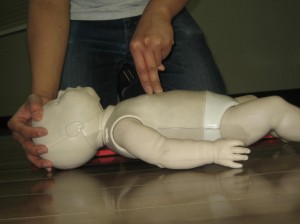In standard first aid training, now available in Red Deer, candidates will learn to clear airway obstructions and restore normal breathing to unconscious patients. Participants will demonstrate the treatment of an unconscious adult with an obstructed airway on a manikin and apply the skills learned in previous sections. The material posted on this page is designed to show candidates the minimum requirements to complete this component of the course. To learn to recognize and treat unconscious victims with obstructed airways take a standard first aid course.
The following is a list of the minimum requirements for candidates to complete this section. Participants must:
- Check the scene for any hazards and mechanisms of injury.
- Determine the cause of injury and history.
- Check the level of consciousness of the victim.
Chest compressions for obstructed airway victims - Position the patient appropriately to be able to open the airway.
- Look, listen and feel for normal or abnormal breathing for 5 seconds.
- Activate emergency medical services (EMS) and obtain a AED (through the use of a bystander if possible).
- In this scenario breathing is absent. Rescuers will landmark and begin 30 chest compressions followed by 2 ventilations. Ventilations are not successful so rescuers must reposition the airway.
- In this scenario ventilations are unsuccessful after repositioning the airway so rescuers must continue with compressions, checking the mouth and attempting to ventilate until the the airway is clear.
- If the patient moves, the rescuer should reassess ABC’s and treat appropriately.
- Whenever possible rescuers should use protective devices and should ask for consent when treating children or infants from parents and caregivers.
For more information about CPR techniques for obstructed airway victims of all ages take a standard first aid course near you. In a credible course candidates will receive significant amounts of hands on training on manikins and other victims to be comfortable and confident with their skills. Courses are available throughout Canada including on the west coast in Victoria, B.C.
